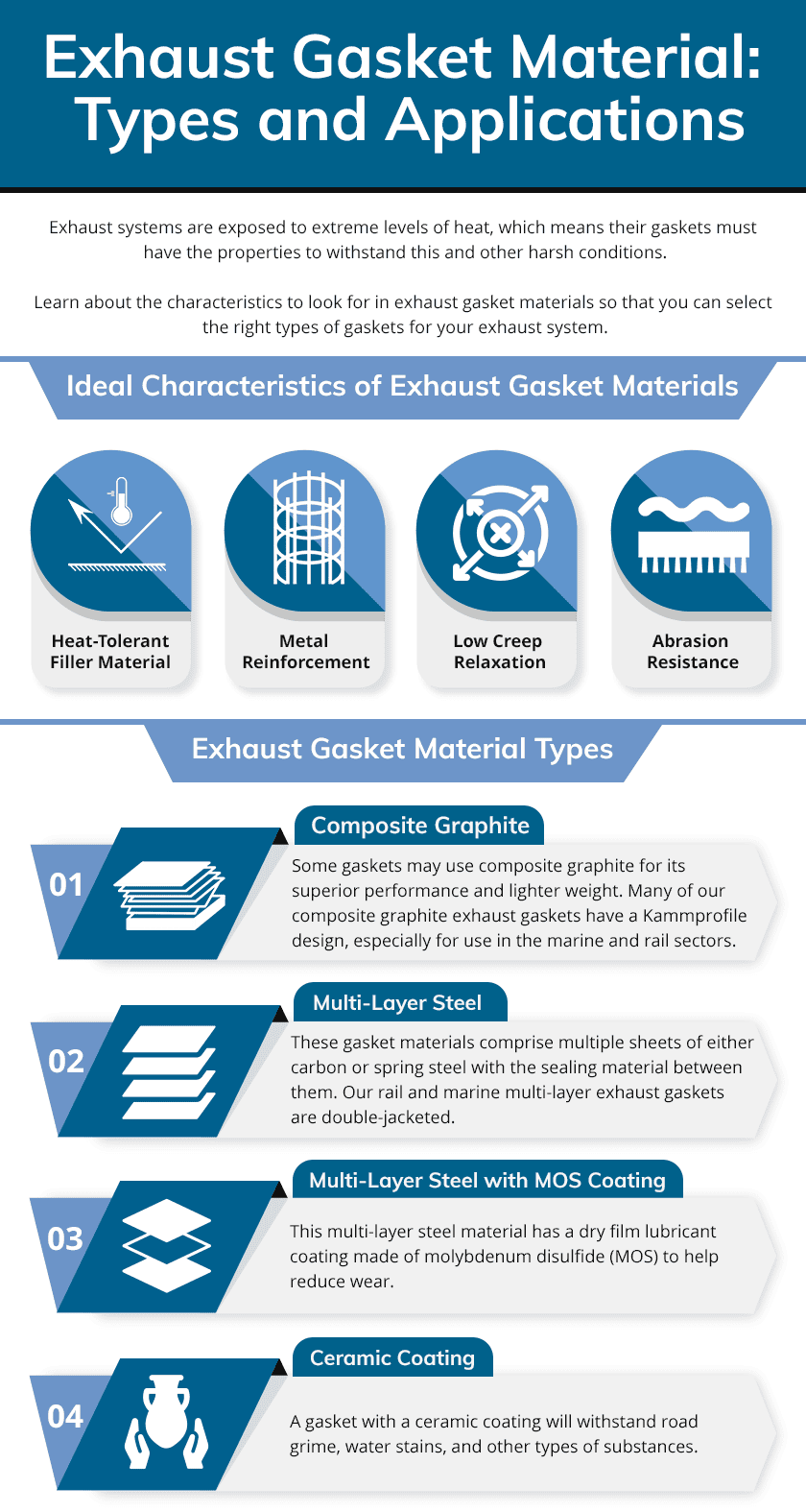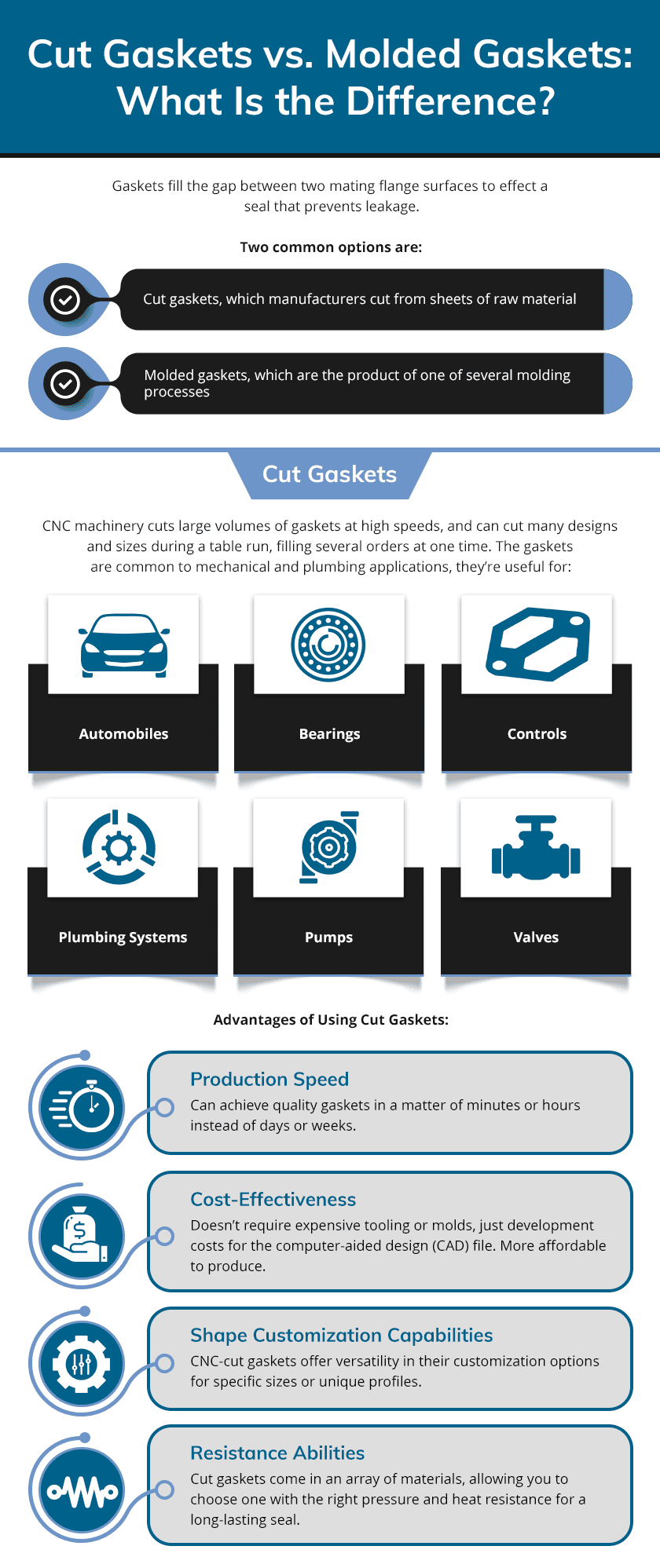Exhaust Gasket Material: Types and Applications
Leave a CommentExhaust systems are exposed to extreme levels of heat, which means their gaskets must have the properties to withstand this and other harsh conditions. Learn about the characteristics to look for in exhaust gasket materials so that you can select the right types of gaskets for your exhaust system.
Ideal Characteristics of Exhaust Gasket Materials
The following are some of the specific characteristics to look for in exhaust gasket material types.
Heat-Tolerant Filler Material
The facing/filler material of the exhaust gasket must be able to handle exposure to high temperatures without any compromise in its structural integrity. Otherwise, the seal can experience premature wear and failure.
Metal Reinforcement
Gaskets with metal reinforcements will benefit from increased durability, strength, and holding power throughout their service life.
Low Creep Relaxation
Graphite filler materials give the gasket low creep relaxation. Low creep relaxation means that the gasket material won’t experience much loss in thickness over time or under exposure to extreme heat. As a result, the gasket will maintain reliable flange loading that keeps the seal intact.
Abrasion Resistance
If your exhaust system contains joints with high thermal motion—including joints made of two or more dissimilar metals with varying contraction and expansion rates under heat—you may benefit from a clad-style exhaust gasket material to resist abrasion.
Exhaust Gasket Material Types
Based on the characteristics required of your gasket material, you may select one of the following gasket material types:
- Composite graphite — Some gaskets may use composite graphite for its superior performance and lighter weight. Many of our composite graphite exhaust gaskets have a Kammprofile design, especially for use in the marine and rail sectors.
- Multi-layer steel — These gasket materials comprise multiple sheets of either carbon or spring steel with the sealing material between them. Our rail and marine multi-layer exhaust gaskets are double-jacketed.
- Multi-layer steel with MOS coating — This multi-layer steel material has a dry film lubricant coating made of molybdenum disulfide (MOS) to help reduce wear.
- Ceramic coating — A gasket with a ceramic coating will withstand road grime, water stains, and other types of substances.
- Sandwich type — These gaskets include two thin layers of aluminum, copper, steel, or another type of metal with a center layer of graphite.
Exhaust Gasket Material Applications
Our exhaust flange gasket materials are compatible with a wide range of exhaust systems from major manufacturers:
- Caterpillar: C7, C9, C10, C12, C13, C15, C27, C32, and G3500 engines
- Cummins: QSK60, IX, ISB, K38, ISX12, and QSB3.3 engines
- Detroit Diesel: S60 and DD15 engines
- Mack: E7 engines
- MTU: Series 4000, Series 396, and Series 2000 engines
- Navistar: DT466 engines
- Volvo: D12 engines
- EMD: 567, 645, and 710 engines
- Wabtec: GE 7FDL engines
Find the Best Exhaust Gasket Materials at MPRC
It’s important to find the right exhaust gasket material for your application based on the types of conditions your exhaust system experiences. At Master Packing and Rubber Company, we provide our customers with innovatively designed and manufactured gasket exhaust materials that meet the requirements of various engines.
For more information about our products and capabilities, request a quote today.
Cut Gaskets vs. Molded Gaskets: What Is the Difference?
Leave a CommentGaskets fill the gap between the surfaces of two parts, joining them and creating an effective seal that prevents leakage. Manufacturers have multiple methods for producing various types of high-quality gaskets, depending upon the material selection, available equipment, and application requirements.
Two common options are cut gaskets, which manufacturers cut from sheets of raw material, and molded gaskets, which are the product of one of several molding processes. Learn more about the unique advantages and proper applications of each type to help you choose the right option to fulfill your gasket needs.
Cut Gaskets Explained
From a sheet of material, CNC machinery cuts large volumes of components at high speeds, producing identical gaskets. They sit between two surfaces and create a tight seal through compressive force, filling any space caused by unevenness, gaps, or imperfections on those surfaces to make up for any design flaws. With common mechanical and plumbing applications, they’re useful for:
- Automobiles
- Bearings
- Controls
- Plumbing systems
- Pumps
- Valves
Advantages of Using Cut Gaskets
Some of the key advantages of CNC-cut gaskets include:
- Production speed. As you won’t need to first create a custom die to generate your gaskets with die-less gasket cutting, you can achieve quality gaskets in a matter of minutes or hours rather than the process taking days or even weeks.
- Cost-effectiveness. CNC-cut gaskets don’t require expensive tooling or molds, just development costs for the computer-aided design (CAD) file to guide the cutting process. This process makes cut gaskets more affordable to produce than using alternate techniques.
- Shape customization capabilities. When you need gaskets in specific sizes or unique profiles, CNC-cut gaskets offer versatility in their customization options.
- Resistance abilities. Equipment systems commonly utilize hot fluids, meaning gaskets must withstand high temperatures and pressures. Cut gaskets come in an array of materials, allowing you to choose one with the right pressure and heat resistance for a long-lasting seal.
Molded Gaskets Explained
Molded gaskets offer more complex and versatile designs. First, manufacturers build a precision mold with a cavity in the shape of the desired gasket. Then they fill the cavity with a plastic, rubber, or other uncured elastomer substrate where, through heat and pressure, the material sets and cures, retaining the mold’s shape.
Three common techniques for producing molded gaskets are:
- Injection molding. The fastest of the molding processes, injection molding produces highly consistent gaskets that minimize or eliminate the need for secondary finishing or trim work due to their optimal surface finish without flashing.
- Compression molding. Manufacturers turn to compression molding to generate large-sized molded gaskets. It’s a cost-effective method with low mold and per-part costs, and it produces little unreusable waste.
- Transfer molding. This process is relatively fast and, compared to compression molding, transfer molding offers enhanced uniformity in gaskets. It’s well-suited to manufacturing molded rubber-to-metal components.
Advantages of Using Molded Gaskets
While there are tooling costs that accompany the molding process, molded gaskets offer a range of benefits, including:
- Enhanced design options. Using custom molds, you can generate three-dimensional gaskets, integrate additional parts into your mold’s design, create parts with varying cross-sections, incorporate engraving, and more.
- Dimensional accuracy. Molded gaskets offer tighter tolerances than cut gaskets, particularly where thickness is concerned. They create a secure bond between surfaces while enabling joint flexibility.
- Improved leakage protection. Molded gaskets don’t have splices, creating fewer opportunities for leakage.
- Minimal waste. Molding generates little material waste, which equates to the added benefit of per-part cost reductions.
Gaskets We Offer
At MPRC, we offer a wide range of gaskets and manufacturing options to suit your needs, including:
- Molded gaskets. Through injection, compression, or transfer molding, molded gaskets form through heat and pressure, offering design freedom, high performance, and close tolerances.
- Lathe-cut gaskets. A CNC lathe turns a tube of material on a mandrel against a tool to cut material away and achieve completed, structurally stable gaskets in the desired shape.
- Extruded gaskets. Elastomeric polymers like uncured rubber are forced through an extrusion die before being cut into the appropriate dimensions, taking the shape — be it simple or complex — of the die.
- Spliced gaskets. These gaskets start as extruded of material cut into specific lengths, after which the ends bond together through heat and/or adhesives for strong joints.
- Metal gaskets. Formed or cut from large sheets of metal or alloys, these highly durable gaskets create a tight seal with good pressure and chemical resistance capabilities.
- Die-cut gaskets. Using a premade die and any of several die-cutting processes, you can cut gaskets with tight tolerances out of a sheet of material.
Find the Gaskets You Need With MPRC
Master Packing and Rubber Company (MPRC) is a leading provider of seals, gaskets, and mechanical packing materials, with USA-made products for clients across the globe. Contact us today to learn more about what type of gasket is the right fit for your next project or to start your order.


